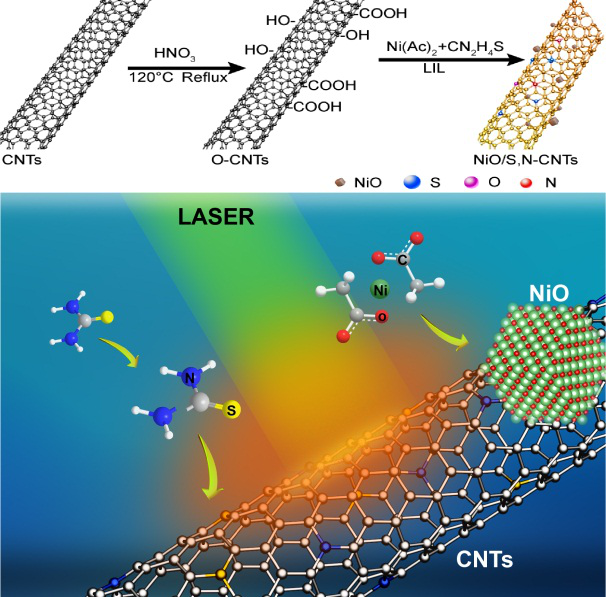
Chinese researchers have reported the synthesis of NiO/S, N-CNTs by laser irradiation in liquids technology, and it is used as a high performance catalyst for electrocatalytic oxidation of methanol.
This work was done by scientists with Institute of Solid State Physics under Hefei Institutes of Physical Science and was published online in Carbon.
Direct Methanol Fuel Cell (DMFC), known as the fourth generation of generating electricity after thermal, hydro and nuclear power technology, provides an effective approach to deal with the energy and environmental crises in future.
Compared to costly platinum-based electrochemical methanol oxidation catalysts that are commonly used for methanol oxidation reaction (MOR), the design of non-platinum electrochemical catalysts with high activity and stability is desirable and challenging.
For this purpose, substantial efforts have been given by changing the intrinsic natures of catalysts in decades, such as fabricating lamellar structures to enlarge catalytic surface area, introducing as much as defects to increase reaction active sites, and decreasing their size to improve adsorption capacity and electronic structures.
Even so, the actual electrochemical reaction environment is so harush that severe aggregation and intermediate species adsorption induced poisoning are easy to damage the activity and durability of catalysts when they are used alone.
To overcome this obstacle, a carbonaceous material is desperately needed as substrate to design an excellent catalyst, which can not only tighly couple catalysts to prevent aggregation, but also help to promote the electron transfer and enhance the MOR performance.
Based on the laser irradiation technology, the team successfully prepared S,N dual-doped carbon nanotubes (S,N-CNTs) with high doping levels of S (4.78 at%) and N (3.58 at%). When it was used as substrate, NiO nanoparticles (NPs) were in-situ loaded on the doped carbon nanotubes.
Electrochemical tests demonstrated that NiO/S,N-CNTs showed a high primary methanol oxidation activity of 2200 mA/mg, a long-term durability with 65.8 % of mass activity maintained after 40000s, and an excellent methanol saturation concentration of 13 M.
This work may provide a facile strategy to fabricate S, N-CNTs and would help to understand the effect of heteroatoms in carbonaceous substrates on boosting the electroactivity of coupled catalysts.
This work was financially supported by the Instrument Developing Project of the Chinese Academy of Sciences, the National Natural Science Foundation of China, and the China Postdoctoral Science Foundation.

Figure 1. Schematic illustration for the laser induced formation of NiO/S,N-CNTs. (Image by SUN Hongmei)

86-10-68597521 (day)
86-10-68597289 (night)

86-10-68511095 (day)
86-10-68512458 (night)

cas_en@cas.cn

52 Sanlihe Rd., Xicheng District,
Beijing, China (100864)

